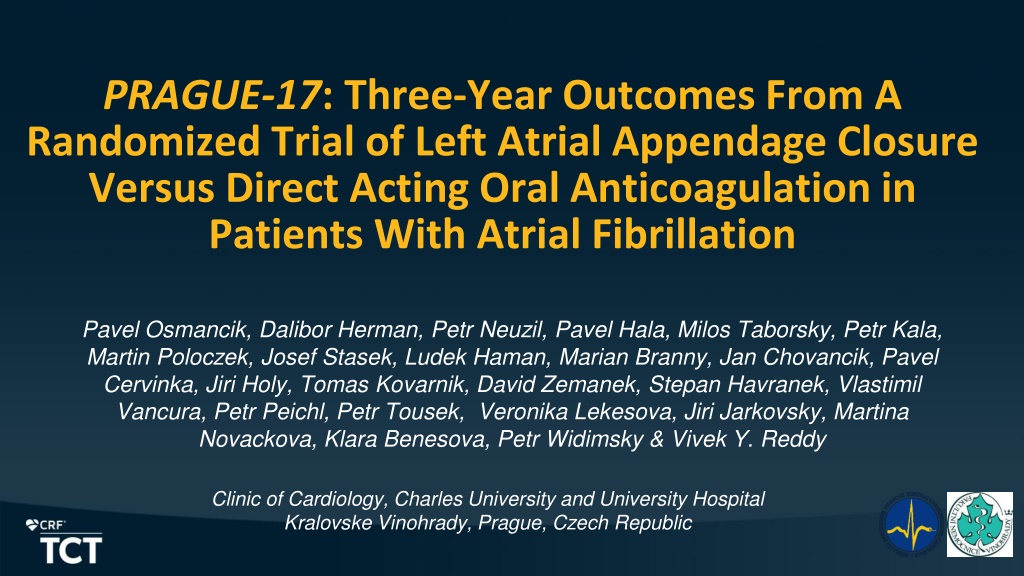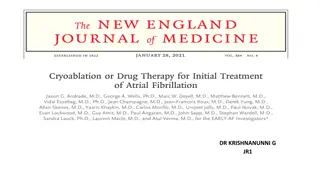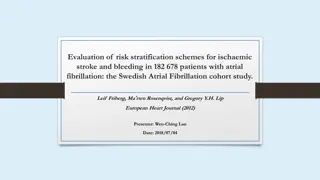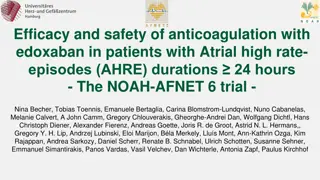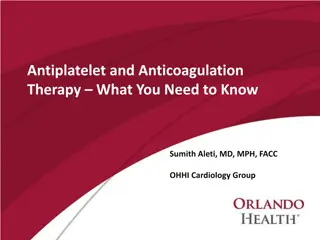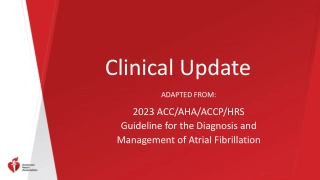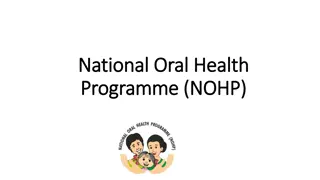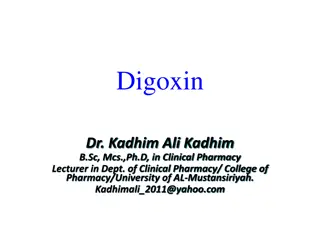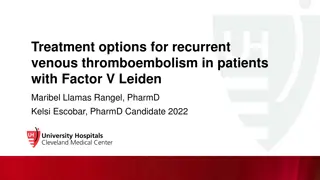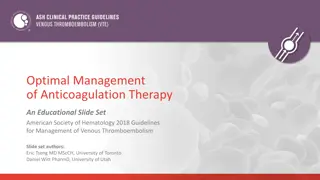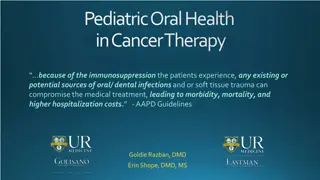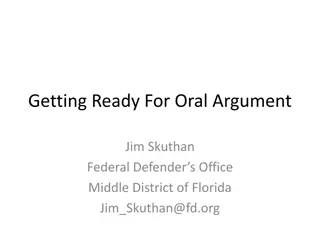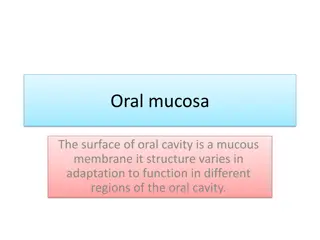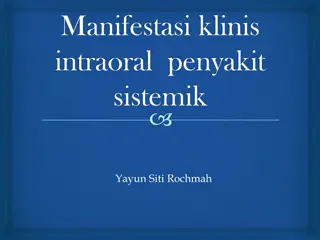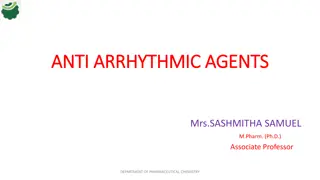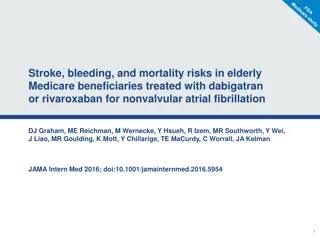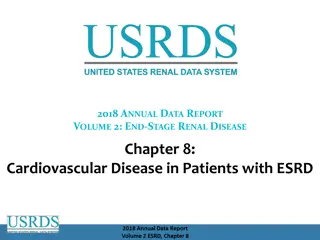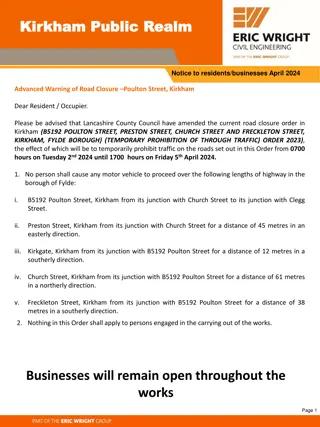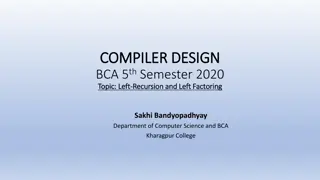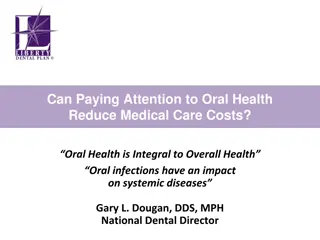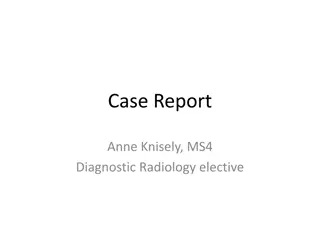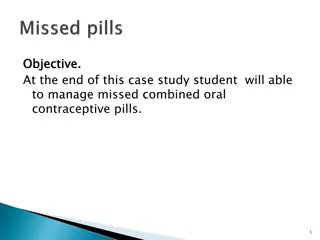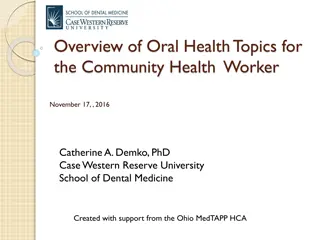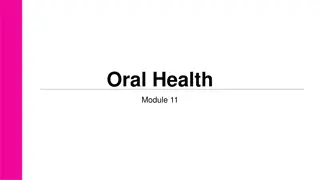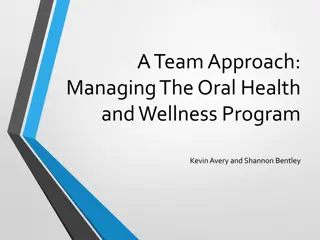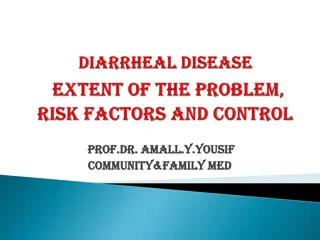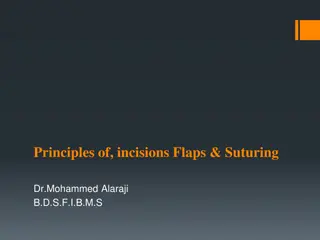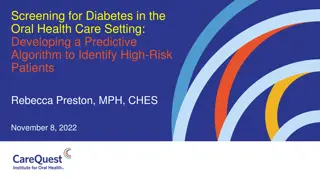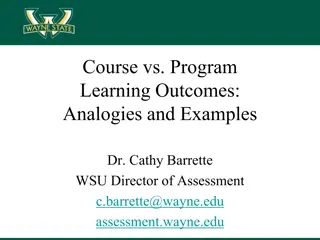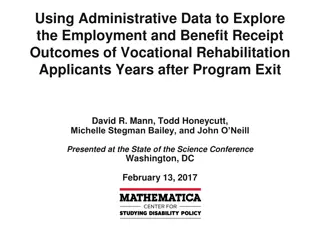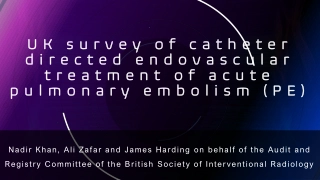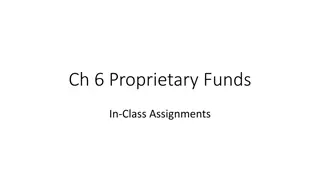Three-Year Outcomes of Left Atrial Appendage Closure vs. Oral Anticoagulation in Atrial Fibrillation
The PRAGUE-17 study compares the three-year outcomes of left atrial appendage closure (LAAC) versus direct oral anticoagulation in patients with atrial fibrillation. LAAC was found to be non-inferior to NOACs for the primary composite endpoint, with similar incidence rates for secondary endpoints. The study suggests that the maximum benefits of LAAC may be observed in the long-term, highlighting the importance of evaluating four-year outcomes.
Download Presentation

Please find below an Image/Link to download the presentation.
The content on the website is provided AS IS for your information and personal use only. It may not be sold, licensed, or shared on other websites without obtaining consent from the author. Download presentation by click this link. If you encounter any issues during the download, it is possible that the publisher has removed the file from their server.
E N D
Presentation Transcript
PRAGUE-17: Three-Year Outcomes From A Randomized Trial of Left Atrial Appendage Closure Versus Direct Acting Oral Anticoagulation in Patients With Atrial Fibrillation Pavel Osmancik, Dalibor Herman, Petr Neuzil, Pavel Hala, Milos Taborsky, Petr Kala, Martin Poloczek, Josef Stasek, Ludek Haman, Marian Branny, Jan Chovancik, Pavel Cervinka, Jiri Holy, Tomas Kovarnik, David Zemanek, Stepan Havranek, Vlastimil Vancura, Petr Peichl, Petr Tousek, Veronika Lekesova, Jiri Jarkovsky, Martina Novackova, Klara Benesova, Petr Widimsky & Vivek Y. Reddy Clinic of Cardiology, Charles University and University Hospital Kralovske Vinohrady, Prague, Czech Republic
Disclosure Statement of Financial Interest I, Pavel Osmancik DO NOT have a financial interest/arrangement or affiliation with one or more organizations that could be perceived as a real or apparent conflict of interest in the context of the subject of this presentation. Faculty disclosure information can be found on the app
Introduction PRAGUE-17 (2019) Left atrial appendage closure (LAAC) was non-inferior to non-vitamin K anticoagulants (NOAC) for the primary composite endpoint (cardioembolism, cardiovascular mortality, clinically-relevant bleeding, and procedure/device associated complications) The incidence of primary endpoint as well as of secondary endpoints (including the non-procedural clinically-relevant bleeding) was similar between groups Since the maximum benefit of LAAC (particularly in terms of bleeding) is expected to be long-term, short-term results could have missed the potential advantage of the LAAC Long-term (4-year) outcomes are presented
Study design PRAGUE-17 (NCT02426944): an investigator-initiated, multicenter, prospective, open-label, randomized non-inferiority trial Goal: to compare LAAC with NOAC in high risk AF patients Enrollment period: October 2015 to January 2019, extended follow- up up to June 2021 Conducted in 10 Cardiac Centers in the Czech Republic, coordinated by Charles University and University Hospital Kralovske Vinohrady, Prague, Czech Republic
Inclusion criteria Non-valvular atrial fibrillation + one of the following: History of bleeding requiring intervention or hospitalization, or I. II. History of a cardioembolic event while taking anticoagulation, or III. CHA2DS2-VASc 3 & HAS-BLED 2
Key exclusion criteria Mechanical valve prosthesis, or mitral stenosis Comorbidities other than AF mandating anticoagulation Patent foramen ovale with large atrial septal aneurysm Mobile aortic plaque Symptomatic carotid arterial atherosclerosis Pericardial effusion > 10 mm Clinically significant bleeding within 30 days Stroke or other cardioembolic event within the 30 days Acute coronary syndrome within the 90 days Creatinine clearance < 30 ml/min If randomized to LAAC, the presence of an LA/LAA thrombus
Randomization Randomization performed using a centralized computer system: LAAC or NOAC in a 1:1 ratio Block sizes varying between 18 22 patients Stratified by center to ensure comparable CHA2DS2VASc scores NOAC group: Rivaroxaban, Apixaban, or Dabigatran at manufacturer-recommended dose, Apixaban preferred LAAC group: Amulet device (Abbott Inc, St. Paul, MN) or Watchman / Watchman-FLX device (Boston Scientific Inc, St. Paul, MN)
Antithrombotic treatment in the LAAC group Default Strategy: DAPT x 3 months: aspirin (100 mg/day) + clopidogrel (75 mg/day) TEE (3 months): clopidogrel withdrawn aspirin continued indefinitely Regimen could be individualized High bleeding risk patients: DAPT could be shortened to 6 weeks Very high thrombotic risk patients: NOAC substitution for DAPT x 3 months, or VKAs x 6 weeks DAPT x 6 weeks, or NOACs x 6 weeks DAPT x 4.5 months
Study outcomes Primary Endpoint: a composite of : (1) Stroke or transient ischemic attack (TIA) (2) Systemic embolism (3) Clinically-relevant bleeding * (4) Cardiovascular death, or (5) Significant peri-procedural or device-related complication. * Clinically-significant bleeding = ISTH major or non-major clinically-significant bleeding. Major bleeding: Either a decrease in hemoglobin 2.0 g/dL over 24-hrs, transfusion of 2 units of packed red cells, bleeding at a critical site (intracranial, intraspinal, intraocular, pericardial, intramuscular with compartment syndrome or retroperitoneal), or fatal bleeding Non-major bleedingis defined as bleeding requiring hospitalization or an invasive procedure, but not meeting ISTH major criteria
Statistics Primary hypothesis: LAAC is noninferior to NOAC for the primary endpoint Primary analysis = modified intention-to treat Also secondary analyses: on-treatment & per-protocol Power calculation: estimated annual occurrence of primary endpoint is 13% for NOACs and 10% for LAAC, to achieve 80% power at a two-sided alpha level of 0.05 for a noninferiority margin of 5% (or 1.47 as odds ratio), 396 subjects needed to enroll
Study CONSORT diagram Lenght of follow-up: 3.5 years (IQR 2.6 4.3) in the LAAC group, 3.5 years (IQR 2.6 4.2) in the NOAC group, for an aggregate of 1,354 patients-years.
Baseline characteristics NOAC (n=201) LAAC (n=201) Age (years) 73.2 7.2 73.4 6.7 130 (64.7%) 134 (66.7%) Male gender (%) 67 (33.3%) 53 (26.4%) Paroxysmal AF (%) 4.7 1.5 4.7 1.5 CHA2DS2-VASc score 54 (26.9%) 56 (27.9%) CHA2DS2-VASc > 6 (%) 69 (34.3%) 73 (36.3%) History of cardioembolic event (%) 3.0 0.9 3.1 0.9 HAS-BLED score 95 (47.3%) 109 (54.2%) History of bleeding/bleeding predisposition 90 (44.8%) 88 (43.8%) Heart failure (%) 186 (92.5%) 186 (92.5%) Hypertension (%) 90 (44.8%) 73 (36.3%) Diabetes mellitus (%)
Treatment characteristics LAAC arm 201 patients allocated to the LAAC arm 14 (7.0%) did not undergo the procedure (refusal, anatomy), 12 pts crossed over to NOAC) 187 patients underwent the procedure; successful in 96.8% (181/187) Implanted devices: Amulet-61.3%, Watchman-35.9% or Watchman-Flex- 2.8%. DAPT in 82% after LAAC. Complications: in 9 pts (4.8%) 16 patients initiated NOAC treatment during follow-up 3 (18%) due to device-related thrombosis on TEE, in 3(18%) due to peri- device leak 5 (29%) due to the presence of cardioembolic event (stroke, TIA)
Treatment characteristics NOAC arm 201 patients allocated to the NOAC arm 2 (1.0%) early cross-over to LAAC (patient preference) 199 patients initiated the NOAC treatment Apixaban 192 patients (96%), 2 x 2.5mg in 33 (16%) pts. 26 patients permanently stopped NOAC treatment during follow-up 15 (58%) due to clinically-relevant bleeding 13 underwent cross-over to LAAC (12 successful with DAPT for 3 months, 1 unsuccesful for anatomical reasons, no complications)
Cumulative incidence function (CIF) for primary study endpoint in intention-to-treat populations LAAC: 8.6 events per 100 pt-years NOAC: 11.9 events per 100 pt-years
Cumulative incidence function for cardiovascular death and all-stroke/TIA in ITT populations LAAC: 3.0 events per 100 pt-years NOAC: 4.4 events per 100 pt-years LAAC: 2.4 events per 100 pt-years NOAC: 2.7 events per 100 pt-years
Cumulative incidence function for clinically-relevant, and non- procedural clinically-relevant bleeding in ITT populations LAAC: 4.3 events per 100 pt-years NOAC: 5.9 events per 100 pt-years LAAC: 3.4 events per 100 pt-years NOAC: 5.9 events per 100 pt-years
Cumulative incidence function (CIF) for primary study endpoint in per-protocol and on-treatment populations
Conclusions In the long-term (4-year), LAAC remained non-inferior to NOAC in preventing major cardiovascular and neurological events in high- risk patients with atrial fibrillation Non-procedural bleeding was significantly reduced with LAAC strategy LAAC may be considered as a non-pharmacological alternative to long-term anticoagulation in patients with AF
Acknowledgements LIST OF INVESTIGATORS: Cardiocenter, Third Faculty of Medicine, Charles University Prague and University Hospital Kralovske Vinohrady, Prague, Czech Republic: Pavel Osmancik, MD, PhD, Dalibor Herman, MD, PhD, Petr Tousek, MD, PhD, Petr Widimsky, MD, DrSc Cardiocenter, Department of Cardiology, Na Homolce Hospital, Prague, Czech Republic: Vivek Y. Reddy, MD, Petr Neuzil, MD, CSc, Pavel Hala, MD, Veronika Lekesova, MD Cardiocenter, Dept. of Cardiology, University Hospital Olomouc, Czech Republic: Milos Taborsky, MD, CSc, Irena Opavska, Mgr, Miloslav Spacek MD Clinic of Cardiology, Masaryk University and University Hospital Brno, Brno, Czech Republic: Petr Kala, MD, PhD, Martin Poloczek, MD, Tomas Ondrus, MD, Lumir Koc, MD 1st Department of Internal Medicine, Faculty of Medicine, University Hospital Hradec Kralove, Charles University Prague, Czech Republic: Josef Stasek, MD, PhD, Ludek Haman, MD, PhD, Josef Bis, MD, PhD, Jiri J ger, MD, Martina Tomkova, MD Department of Cardiology, Cardiocenter, Hospital Podles a.s., Trinec, Czech Republic: Marian Branny, MD, PhD, Jan Chovancik, MD, PhD, Libor Sknouril, MD, PhD Department of Cardiology, Krajsk zdravotni a.s., Masaryk hospital and UJEP, Usti nad Labem, Czech Republic: Pavel Cervinka, MD, PhD, Jiri Holy, MD Cardiocenter, 2nd internal clinic Cardiology and Angiology, Charles University, General Faculty Hospital, Prague Czech Republic: Tomas Kovarnik, MD, PhD, Stepan Havranek, MD, PhD, David Zemanek, MD, PhD Department of Cardiology, University Hospital and Faculty of Medicine Pilsen, Pilsen, Czech Republic: Vlastimil Vancura, MD, PhD, Richard Rokyta, MD, PhD, Jan Lhotsky, MD Cardiocenter, Institute of Clinical and Experimental Medicine, Prague, Czech Republic: Petr Peichl, MD, PhD, Bronislav Janek, MD, Prodrag Stojadinovic, MD Statistics and IT, Masaryk University, Institute of Biostatistics and Analyses, Czech Republic: Dr. Jiri Jarkovsky, PhD, Sarka Haskova, Mgr,Martina Novackova, Mgr., Klara Benesova, Mgr DATA SAFETY AND MONTIORING BOARD: Jaromir Hradec, MD, CSc, Frantisek Tousek, MD, Rostislav Polasek, MD
